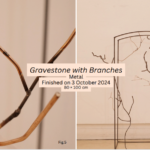Reflections on Recent Exhibitions
Recently, I visited the exhibition Sisters!, curated by Petra Bauer at the Fruitmarket Gallery in Edinburgh. This exhibition explored themes of female collaboration and collective action, emphasizing women’s roles in social change. Through various media, including film, photography, and archival materials, the exhibition vividly presented how collective memory is formed and how historical narratives shape individual identities. The exhibition’s focus on collaboration, collective memory, and social engagement made me reflect on how, in discussing the theme of “death” in curatorial practice, I should not only focus on personal experiences of death but also examine how collective memory influences our perception of mortality.
Reflections on My Previous Blog Posts
Looking back at my previous blogs, my discussions primarily centered on the individual experience of death and its philosophical interpretations, such as existentialist views on mortality, Eastern philosophical perspectives on life and death, and the influence of color symbolism on perceptions of death. While these discussions had strong conceptual depth, they leaned more toward personal and abstract expressions. Petra Bauer’s curatorial approach inspired me to consider that death is not merely the end of an individual life; it also involves collective mourning, rituals, and memory construction.
If we understand death as a collective experience, then it is not just about the disappearance of an individual but also about the continuation of cultural, historical, and social identity. In many cultures, mourning rituals are not only commemorations of the deceased but also reaffirmations of group identity for those who remain. This led me to consider how curatorial practice can explore the social dimension of death and its lasting imprints on collective memory and cultural heritage.
Initial Concept for My Curatorial Theme
After reflecting on recent exhibitions and further refining my research theme, my curatorial concept has become clearer:
“Eclipsing Presence – The Colors of Death and Collective Memory”
This exhibition will explore how death is not only the end of an individual life but also an integral part of collective identity and cultural memory. For instance:
- Color Symbolism and Death: How do different cultures encode death through color, and how does this influence collective memory?
- Rituals and Commemoration: How do different societies sustain the memory of the deceased through rituals?
- Death in the Digital Age: How has the internet changed mourning practices? Will digital archives become a new space for collective remembrance?
Additionally, the exhibition will feature interactive elements, encouraging visitors to share their experiences and reflections on death, transforming the exhibition into a constantly evolving platform for collective memory.
Conclusion
Curating is a continuous journey of exploration and refinement. From individual experiences of death to the way collective memory shapes our understanding of mortality, I hope this exhibition will not only delve into the philosophical and emotional dimensions of death but also examine how it is documented, transmitted, and reinterpreted as part of cultural heritage. Moving forward, I will continue to explore ways to create spaces in curatorial practice where audiences can actively participate and engage in meaningful dialogue and shared reflection.
References:
- Bauer, P. (2024). Sisters! [Exhibition]. Fruitmarket Gallery, Edinburgh. Retrieved from https://www.fruitmarket.co.uk/event/petra-bauer-sisters/
- Morton, T. (2013). Hyperobjects: Philosophy and Ecology after the End of the World. University of Minnesota Press.
- Hochschild, A., & Machung, A. (1989). The Second Shift: Working Parents and the Revolution at Home. University of Chicago Press.
- Hertz, R. (1990). The Second Shift: Working Parents and the Revolution at Home. The American Journal of Sociology, 96(3), 776–778.
- University of Edinburgh. (2024). Time as Concept and Material in Curation. Retrieved from https://uoe.sharepoint.com/:b:/s/PGTCohort/EdyVdwDt31NItOy8wdcIbpABqUnHxRgGwnh5HAovtE4K0w





s2630451
25 February 2025 — 21:17
Your blog presents a well-developed curatorial exploration, evolving from individual experiences of death (Week 3 and 4) to collective memory (Week 5). The integration of philosophical perspectives (Daoism, Sartre, Beauvoir) enhances the depth of your analysis, and the case study of Sisters! effectively connects theory with curatorial practice.
A key strength is your discussion of digital mourning and its role in contemporary curating. However, you could expand on how these ideas translate into exhibition design. Would audience participation play a role? How might digital archives interact with physical exhibitions? Including more case studies—such as Facebook memorialized accounts or online commemoration spaces—would strengthen your argument.
Overall, your blog demonstrates strong theoretical engagement. Refining the connection between your conceptual framework and practical curatorial applications would further enhance its impact.